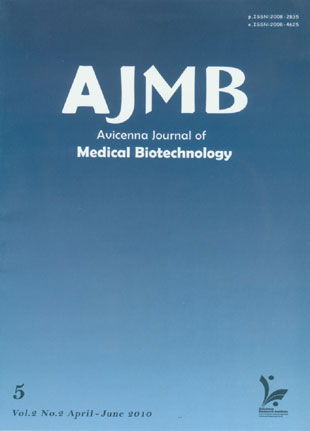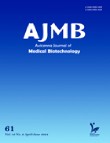فهرست مطالب

Avicenna Journal of Medical Biotechnology
Volume:2 Issue: 2, Apr-Jun 2010
- تاریخ انتشار: 1389/05/01
- تعداد عناوین: 7
-
-
EditorialPage 67
-
Page 69We have employed a peptide-based antibody generation protocol for producing antibody against human nestin. Using a 12-mer synthetic peptide from repetitive region of human nestin protein devoid of any N- or O-glyco-sylation sequences, we generated a mouse monoclonal antibody capable of recognizing human, mouse, bovine, and rat nestin. A wide variety of nestin proteins ranging from 140-250 kDa was detected by this antibody. This antibody is highly specific and functional in applications such as ELISA, flow cytometry, immunocytochemistry, and Western blot assays.
-
Page 79Angiotensin II, the main component of the renin-angiotensin system, is associated with cardiovascular diseases such as hypertension, vascular remodeling and inflammation. Remodeling process results from dysregulation of Matrix Metalloproteinases (MMPs) and their tissue inhibitors (TIMPs). MMPs are considered as important target genes for angiotensin II. The aim of this study was to determine the effects of angiotensin II on MMP-9 and TIMP-1 production and MMP/TIMP balance in a monocytic cell type. Human monocytic U-937 cells were cultured and treated with 100 nM angiotensin II. Supernatants were analyzed for MMP-9 and TIMP-1 using ELISA and zymography methods. Real-time PCR was utilized to evaluate relative MMP-9 and TIMP-1 genes expression following treatments. Cytotoxicity potentials of treatments were determined by assaying lactate dehydrogenase leakage from the cells. Stimulation of the monocytic cells with angiotensin II significantly increased MMP-9 and TIMP-1 secretion as measured by ELISA (p<0.05). It also augmented gelatinolytic activity of MMP-9 in the conditioned media as much as 49% (p<0.05). Incubation of the cells with angiotensin II for 12 hr increased MMP-9 and TIMP-1 gene expression 2.7 and 1.8 folds, respectively (p<0.05). Angiotensin II treatments did not establish significant cytotoxic effects. In summary, our data provide further evidences that monocytic MMP-9 is a major effector of angiotensin II. It is induced more efficiently than TIMP-1 by angiotensin II that leads to MMP/TIMP imbalance. Our data also reveal the pivotal participation of these cells in pathological cardiovascular remodeling mediated by angiotensin II.
-
Page 87R-Phycoerythrin (R-PE), a fluorescent protein from phycobiliprotein family, is isolated from red algae. Conjugation of antibodies to R-PE facilitates multiple fluorescent staining methods. In the present study polyclonal antibodies and polyclonal F(ab'')2 fragment antibodies were conjugated to R-PE by two different methods. The efficiency of the methods was evaluated using Immunocytochemistry (ICC) and Sodium Dodecyl Sulfate Polyacrylamide Gel Electrophoresis (SDS-PAGE). In the first conjugation method, PE was attached to SMCC linker followed by conjugation of antibody to PE-SMCC. In the second method, SH groups were added onto R-PE molecule, while the antibody was attached to SPDP linker. Then, the antibody-SPDP molecule was conjugated to R-PE. Our results showed that the two conjugation methods did not have any abrogative effects on the antibody binding activity.
-
Page 93Chemodiversity in plants provides sources of great value which might be helpful for finding new leads in drug discovery programs. Fabaceae as the third largest family of flowering plants was chosen to investigate its possible antifungal activity. In order to increase the effectiveness of the result, molecular similarity methods and chemical data were used. Twelve plants were selected from Fabaceae and collected from the North and South of Iran. Percolation method with 80% ethanol was used for extraction of collected plants. Antifungal activities of these extracts were determined using broth microdilution method against Candida albicans (C. albicans) ATCC 10231, Aspergillus fumigatus (A. fumigatus) AF 293 and Asperigillus niger (A. niger) ATCC 16404. Extracts with promising activity were screened for toxicity with larvae of Artemia salina (brine shrimp). Dalbergia sissoo, Lathyrus pratensis, Oreophysa microphyalla, Astragalus stepporum, Ebenus stellata, Sophora alopecuroides, Ammodendron persicum and Taverniera cuneifolia showed activity against at least one of the microorganisms used in this study. According to the results of our experiment, the extracts of these plants can be used for further investigation in therapeutic research.
-
Page 101Adjuvant induced arthritis is a chronic crippling, skeleton-muscular disorder having nearest approximation to human rheumatoid arthritis for which there is currently no medicine available effecting a permanent cure. Even modern drugs used for the amelioration of the symptoms, offer only temporary relief and also produce severe side effects. In the indigenous system of medicine, wood of Premna serratifolia Linn., is reported to be useful in the treatment of arthritis. It is a large shrub, distributed throughout Asia, used against a wide variety of diseases. However, no systematic study has been reported regarding its anti-arthritic activity. This work was aimed at the scientific validation of the ethno-pharmacological claim about its anti-arthritic property. In the present study, anti-arthritic activity of ethanol extract of Premna serratifolia Linn., wood is done by Freund''s adjuvant induced arthritis model. Loss in body weight during arthritis condition was corrected on treatment with ethanol extract and standard drug, indomethacin. Biochemical parameters such as hemoglobin content, total WBC, RBC, erythrocyte and sedimentation rate were also estimated. The ethanol extract at the dose of 300 mg/kg body weight inhibited the rat paw edema by 68.32% which is comparable with standard drug indomethacin 74.87% inhibition of rat paw edema after 21 days. The results of the current investigation concluded, ethanol extract of Premna serratifolia Linn., wood possess a significant anti-arthritic activity against adjuvant induced arthritis and justifying its therapeutic role in arthritic condition. The observed anti-arthritic activity may be due to the presence of phytoconstituents such as irridiod glycosides, alkaloids, phenolic compounds and flavonoids.
-
Page 107Improvements on embryo micromanipulation techniques led to the use of embryo biopsy in commercial embryo transfer programs for genetic analysis of preimplantation bovine embryos. The aim of this study was to evaluate the quality of bovine blastocyst derived from embryos biopsied at different precompacted morulae stages by assessment of cryosurvivability of the resulting blastocysts. The in vitro produced bovine embryos were subjected to biopsy at days 2, 3, and 4 post-insemination with different cell numbers (4 to 16-cells). Embryo cell biopsy was carried out in a 100 l drop of H-SOF following pronase drilling by aspiration of one blastomere. The biopsied embryos were then cultured in SOFaaBSA co-cultured with oviduct cells-monolayer until blastocyst formation. The blastocysts were cryopreserved at room tempera-ture after exposure of equilibration (glycerol 1.4 M for 5 min and then glycerol 1.4 M and ethylene glycol 3.6 M for 5 min) and vitrification solutions (3.4 M glycerol and 4.6 M ethylene glycol). The blastocysts were loaded into the center of 0.25 ml straws separated by air bubbles from 2 columns of sucrose 0.5 M and plunged immediately into liquid nitrogen. There was no significant difference in cryosurvivability of vitrified-warmed blastocysts derived form biopsied embryos at different pre-compacted morula stages. The quality of biopsy derived blastocysts was identical to that of non-biopsy derived ones in terms of post vitrifcation survival and hatching rates. In conclusion there was no preference between different times of embryo biopsy at precompacted morula stages in term of cryosurvivability of biopsy derived bovine blastocysts.


